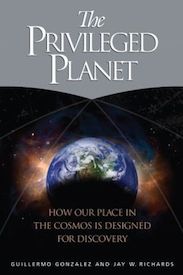The Privileged Planet
Well, not at the geographical center — but here is proof that one of the most cherished assumptions of materialism, that Earth is an insignificant dust speck in an obscure corner of the universe, is dead wrong. “The Privileged Planet: How Our Place in the Cosmos is Designed for Discovery” provides proof that Earth is a lot more significant than virtually anyone has realized — except for tenacious post-Copernican theists.
Guillermo Gonzalez and Jay W. Richards present mountains of evidence that exposes the hollowness of today’s scientific orthodoxy. They demonstrate that Earth is carefully designed not only to support life, but to give us the best possible view of the universe — as if the great Designer of the cosmos wanted to help us discover His handiwork. Their investigations are wide-ranging, covering star probes, the physics of the moon, polar ice cores, plate tectonics, our neighboring planets, and much more. Gonzalez and Richards also set out the explosive implications of the facts they present here, and even answer sixteen common objections to the idea that Earth is the product of design.
The Privileged Planet’s astounding findings should lead any open-minded individual to reevaluate entrenched assumptions about the universe — and even to reconsider our very purpose on what so many have dismissed as a tiny speck orbiting an inconsequential star in one galaxy among billions. As such, this book is a direct and enormously valuable challenge to one of the key foundations of the philosophical relativism that plagues the Western world today. Among the revelations:
- Copernicus: how the popular idea of his achievement contains more ideologically skewered myth than historical accuracy
- Self-contradictions and unanswerable questions that doom the “Copernican Principle” — the flawed idea that there is nothing special about Earth or its place in the universe — as a viable theory, despite its almost universal acceptance today
- Did God design our surroundings for us to discover information about them? The close relationship between the measurable aspects of our environment and its suitability for supporting human life
- Why Earth would support no life if it were just a bit smaller or larger
- How Earth is perfectly positioned to allow us to map the structure of our galaxy even though we are inside it
- Why the night sky is dark (and perfect for celestial observation), even though the multiplicity of stars should produce an intensely bright sky, day and night
- Earth and the Moon: how they function together as one intricate system — and how the Moon is radically different from every other known planetary satellite
- Our atmosphere’s perfect balance: how it transmits most of the radiation that is useful for life while blocking most of what is lethal
- How Mars does nothing less than protect the Earth from cataclysmic destruction
- Four astounding “coincidences” that ensure that our atmosphere contains just the right amounts of carbon and oxygen for human beings and other living things
- Two important ways that Earth’s magnetic field and atmosphere shield us from factors that would have prevented life from ever developing
- The importance of gravity: how a stronger or weaker gravitational force would not only change the stars and planets, but alter the cosmos as a whole
- Polar ice: what it reveals not only about climate changes and other developments on Earth, but about extraterrestrial phenomena
- Water: striking ways in which it doesn’t behave the way most other liquids do — each of its eccentricities makes it more useful for sustaining life
- Why it’s surprising that Earth has gone so long without another global Ice Age: the simple substance, found in our atmosphere in abundance, that prevents a recurrence
- Earthquakes: not just sources of destruction, but inevitable outgrowths of geological forces highly advantageous to life
- Two major long-range extraterrestrial dangers — and how Earth manages to avoid them
- Stars: their remarkable usefulness as testing grounds for the laws of physics
- Four fundamental forces that have fine-tuned our universe’s ability to sustain life
- The Sun: a fairly ordinary and typical star? Hardly: it has numerous important, anomalous, and life-permitting properties
- The significance of the recently discovered fact that other solar systems differ from ours in many important ways
- Why the sheer number and size of galaxies does not mean that our universe’s capacity to sustain life is just the result of blind chance
- The Author

Guillermo Gonzalez
Guillermo Gonzalez is an Assistant Professor of Astronomy at Ball State University and a Senior Fellow at Discovery Institute’s Center […] More about Guillermo Gonzalez.
Ratings Details














